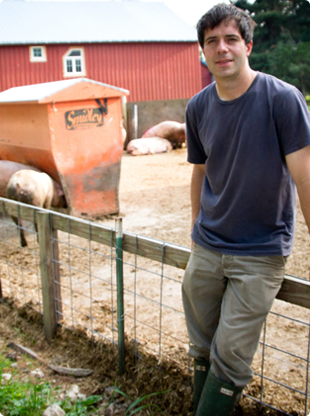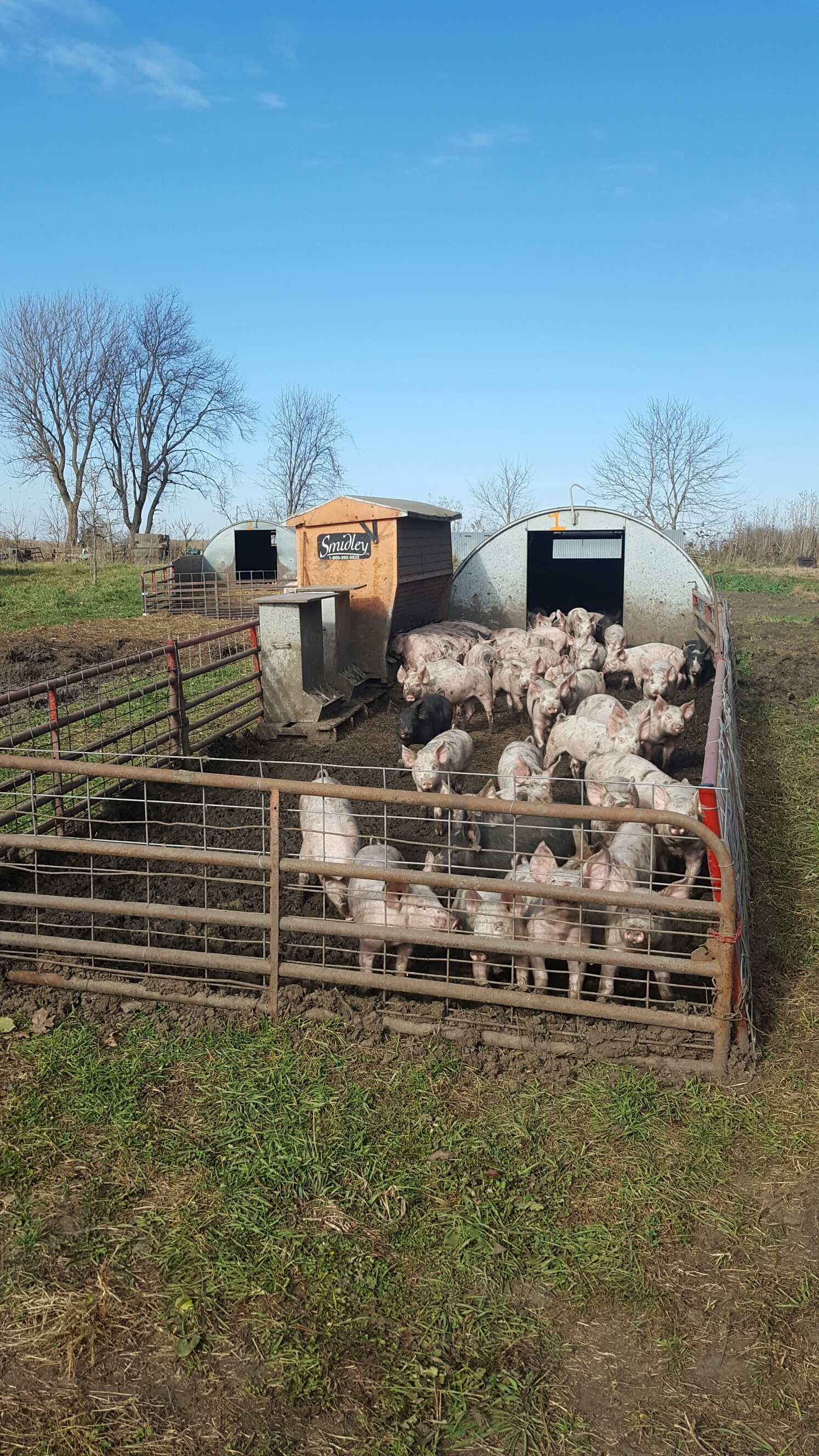Jude Becker, Becker Lane Organic
A Vision for Raising Greener Hogs & Producing Fresher Meat
JUDE BECKER, BECKER LANE ORGANIC
A VISION FOR RAISING GREENER HOGS & PRODUCING FRESHER MEAT
by Joe Pedretti, Outreach Manager

Jude Becker is the 6th generation of his family to farm the land near Dyersville, Iowa. The farm has 200 tillable acres, with some trees and permanent pasture. All of it is certified organic.
A small farm by current Iowa standards, but one with a deep history and strong commitment to humane animal husbandry and sustainable principles.
Certified organic since 2000, Jude started by only doing organic grain, but slowly began producing organic hogs. Today, Jude has 140 sows and direct markets 2000 pigs per year, all under his Becker Lane Organic label.
“It was a traumatic path to to get to 100% direct. We made some mistakes by moving too quickly after some success. I continued to expand the hogs based on a commitment from a single customer. After 18 months they cut their price. You need enough customers so that any one customer can’t threaten the farm. Today we sell to restaurants in California, grocers in Texas, and we export to Japan and Hong Kong. That’s healthy. You don’t want to depend upon one kind, or one customer in our business. That gives me power,” emphasized Jude.
“Being certified organic buys you market access. There is no legal framework for the other natural claims, so being certified has opened a lot of doors. People were looking for organic meat. Finding those people took a lot of work. I didn’t have my own label at first. I am glad we did that. Building your brand is important. Create your own identity. The end consumer has no idea where their food comes from. It is very important to get your name in front of them. My dream was to sell this meat from one specific person- me. This has allowed me to be on my own and independent,” said Jude.
“After I created my label, I built a website with pictures, farm history and narratives. You need to connect with customers and tell them your story. They want that connection.”
Processing was one of Jude’s biggest challenges. “Although it is easier for processing plants to get certified, many did not have enough organic interest to consider the transition. This continues to be a big challenge for small farmers. I single-handedly worked with four different plants to get them certified. MOSA stepped up to help with the process. The logistics of shipping fresh meat was a real victory for us. We can reliably ship fresh meat anywhere in the world. I worked with good quality assurance professionals to really understand the factors that affect shelf life. A good processing plant, willing to work with you and your specifications is key. You can greatly improve shelf life with good sanitation and QA processes.”
“My family was always put off by industrial indoor pig production. I could not live my lifestyle and be true to my beliefs and values using confinement. I can’t deny that the organic price is important, but the initial trigger to go organic was more aesthetic and philosophical. My family celebrated the rural life. We farmed by the seasons. It was that approach, and what I learned at Iowa State about sustainable agriculture, that led me to a pasture-based, humane system of raising pigs. There was no USDA Organic in the late 1990s. The only thing people were raising organic in Iowa was soybeans, so I had to do a lot of research and experimenting on my own.”
“I started by transitioning the farm. It had been leased to a conventional corn/bean farmer, so it took three years. I then reconstructed and remodeled nearly every building and worked hard to rebuild the soil. I was certified in 2000. At first, I just sold organic cereal grains, soybeans, and corn, and then I slowly started to add the hogs. Looking back I would say don’t be too aggressive to take on debts in the beginning. Cooperate with others who have the assets if you can.”
“All the sows are housed on pasture during pregnancy. My sow pasture is part of my rotation. After 1-2 years in corn, I plant the fields to oats or barley with an underseeding of grasses and legumes. I wait a full year for the grass to establish before I put the sows on the pasture, and that field will stay in pasture for 2-3 years. I put no more than six sows per acre.”
“I made my own A-frame farrowing huts at first, but on a trip to Denmark in 2003, I saw some more sophisticated systems. I bought some from the English company that makes them. They are sturdier, heavier, insulated, and more easily moved. Denmark has a much more advanced pasture based system than we do, because their government has invested in the development.”
“All of the farrowing houses are bedded with straw. The piglets stay with their mothers in the houses until they are weaned at six weeks of age. They are then brought back to be weaned in group housing."

In 2015, I switched to a European system for weaning piglets. It is a big, portable house, a lot like a portable chicken tractor. Each house has a front yard that is three times as big as the house. I feed inside with a self-feeder, water with a 50 gallon barrel nipple drinker which is filled once a day. 50-60 pigs are kept in each house, and we move it every few weeks to new pasture. I have had a big reduction in scours and animal losses since I switched to this system. My post-weaning mortality was 10% before, and is now down to 2%,” noted Jude.
The pigs are kept in group housing for five weeks, and then moved to hoop buildings for fattening.
“I have been moving towards AI. We have better control over our breeding. It has been a learning process on maternal breeds. I started with Chester Whites, and then went to Landrace, but found that they were too fragile. I have settled on F2 or F3 crosses, with some Chester White, some Duroc, and some Landrace. These crosses are more durable and I have less losses.”
Jude has stopped producing soybeans, finding them too difficult on his farm. “Each farm should grow what it is best suited for. I had too many weeds and soil loss with soybeans. I now rotate corn, oats/barley, and hog pasture and buy my soybean meal from Cashton Farm Supply.”
Jude is well situated to comply with the new Organic Livestock and Poultry Practices Final Rule which go into effect this year (see ‘Certification Policy Update’ in this issue). “I support the addition of an animal welfare provision to the organic standards. It is difficult getting everyone to agree since we have such widely diverse climate and conditions geographically. Some have said that animal welfare has nothing to do with organic farming, I strongly disagree with that, and I object to some practices and weak rules that allow farms to meet the bare minimum while virtually farming animals indoors. My animals and my customers deserve better.”
To learn more about Jude’s farm and Becker Lane Organic Meat, visit his website at: Becker Lane Organic | Certified Organic Pork | Berkshire, Chester White

